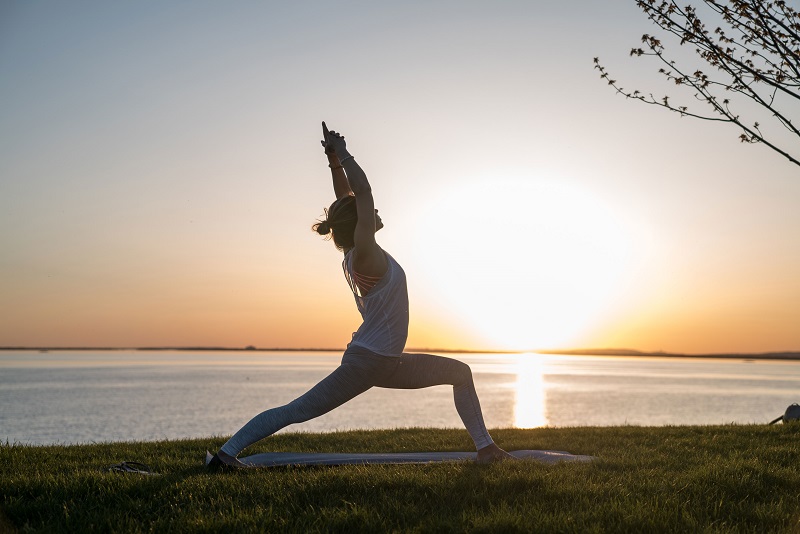To be connected, to keep in touch, to keep together. Even more simply union and, expanding the concept a little, to combine several things to make them one: these and others the meanings of the term “Yoga” which derives from the Sanskrit root yuj. It is well known and recognized that yoga is a very effective discipline for the well-being of our bodies. It helps us to fight tensions and stress; it relaxes us and allows us to observe ourselves. And what surrounds us from another point of view and in a positive way. Same thing when we talk about yoga in pregnancy.
In the nine months of pregnancy, the watchword is a balance between body and mind, between mother and baby. Who must try to find the right harmony? In addition to a classic walk, yoga can be the ideal tool to continue taking care of oneself. And the reflection of those who carry them on their laps.
Yoga during pregnancy: the benefits for body and mind
In all transformation processes, it is essential to know and perceive oneself in the various phases of body change. For this reason, it is important to be guided by experts in sports and to seek an open. And continuous comparison with the gynecologist.
You can start practicing yoga in pregnancy at any time even if some suggest waiting after the first three months, the most delicate. The benefits of this discipline on future mothers are many. We discover we discover the most frequent together.
Expectant mothers who regularly practice a prenatal yoga class experience a decrease in nausea, insomnia and the typical back pain that often accompanies sciatic nerve pain; yoga helps to lengthen the spine, redistributing the weights as the belly increases.
Correct breathing increases oxygenation levels in the blood not only in the mother. But also in the baby.
There is a general improvement in body tone. And muscle elasticity which also affects the pelvic area.
Body and mind must travel and stabilize on the same wavelength; the one should support it. And compensate the other and vice versa; during pregnancy doubts, fears and anxieties risk undermining the serenity with which one should wait for the big day. To avoid the shadows of pre-birth stress yoga during pregnancy can play a precious role. Promoting that feeling of relaxation that is desirable. And indispensable for maintaining good contact and a good. And harmonious union with your child, strengthening that bond that will then last for a lifetime.
Yoga during pregnancy also allows you to stop, listen. And communicate with the baby; this listening attitude, not only pleasant, tender and sometimes extraordinary, can also have a therapeutic effect on the mind and body.
Back pain in pregnancy, the exercises to do
The back pain is a real obstacle in everyday life, especially between the second and third quarters. Limiting the quality of life and constitutes one of the most typical and least endured pregnancy pains. In addition, just think that the tiredness accumulated over the course of a day makes the back pain almost unbearable in the evening, making the night hours unpleasant. The shocks in the back and contractures in the back are the most common ailments.
Here is an exercise that could give some relief: with the soles of the feet joined the knees open sideways, place your hands on the knees, inhale by opening the chest and raising the chin as if stretching upwards and forwards. Exhale by closing the chin towards the sternum going backward with the trunk, as if closing in a hedgehog. Repeat 10 to 30 slow movements in this manner.
The position of the cat is also a good remedy for aching back. Get on all fours with your knees and hands on the mat. Make sure you have your wrists under your shoulders and your knees under your hips. Open your fingers well and press the ground with your knuckles.
Inhale with your nose and arch your back down. Then raise your head and look up like this. Then always throw the air out through the nose and do the opposite movement, arching the column upwards and lowering the head and looking towards the chest trying to bring the chin towards the column, just like a cat while stretching.
Yoga exercises for pregnancy
Tasanda (mountain): While standing, spread the legs slightly, the arms remain stretched along the body, the palms of the hands against the thighs, straight head and narrowed eyes facing the horizon. Exhale, move your arms a little away from your body and stop when they form a sort of triangle (the mountain, in fact). Remain in position, breathing quietly 3-4 times, as if the two arms were the sides of the mountain, the feet its base, the head washes. Bring your arms back to your body and relax your legs. Repeat 2 times, increasing the static by 1 breath each time.
Bhadrasana (butterfly)
While sitting with the legs stretched out in front, bend the knees, join the soles of the feet and bring them closer to the pelvis. If you can grab the two feet with your hands clasped, otherwise leave your arms behind, leaning on your hands. Straighten your back and breathe quietly 1-3 times. Return, rest and repeat 2 more times, gently pushing the knees towards the floor with each exhale and letting them return to each inhalation. It is the movement of the butterfly’s wings.
Shavasana (rest)
Stretched out on the back, legs spread apart, feet dropped out, arms away from the body, palms facing upwards, eyes closed and chin retracted. Breathe quietly. If the back protests, bend the knees and place the feet on the ground, towards the pelvis; if I struggle to lie down (it is likely after the fourth or fifth month) replace this position with the next one.
Sahajana-Buddhasana (sleeping Buddha)
Lie on your side, your legs perfectly on each other, stretched. A hand supports the head, with the elbow bent and the armpit in contact with the floor; the other armrests on the upper side. Stay in position, breathing quietly 5-7 times, with your eyes closed, observing the movement of the abdomen during breathing. Change sides and repeat for the same times.
Malasana (garland)
Standing, legs apart, go down to the floor until you almost sit down, bending and opening your knees, trying not to lift your heels off the ground. Join your hands in front of your chest, with your elbows pushing your knees outward; also slightly bend the head towards the clasped hands. Stay in the position for 3-5 quiet breaths, each time relaxing the perineum (the muscle between the anus and the vaginal opening). Return by placing your hands forward to stretch your legs and also lift your upper body without forcing your back. Rest and repeat 2 more times, increasing the static each time by 1 breath. The position of the garland, or malasana, is very useful for keeping the pelvic floor tonic and elastic, it is very useful for the labor .
Postpartum yoga
The arrival of a child involves an inevitable transformation of one’s life, if not a real upheaval; yoga can also help to face post-partum to find oneself and reposition oneself more serenely in a renewed daily life. To alleviate anxieties, tensions, and worries and find the energy and improve the physical appearance, it would be advisable not to abandon the good habits acquired over time and a few weeks later you could start from the basic positions, albeit without forcing.
Practicing yoga during pregnancy helps not to undergo this phase, but to live it fully with the right awareness, starting to savor the delicious taste of everything that will come.
Tags: Tips to Yoga during pregnancy, Top tips to Yoga during pregnancy, Yoga during pregnancy








Leave a Reply